
Is it (stills) worth buying graphics cards just for crypto mining?
Gamer graphics cards are becoming more expensive and it’s difficult to get your hands on them. The boom in crypto mining seems to be to blame. I also sent my GTX 1080 Ti down the mine to find out if I really could make a bit of cash out of it.
«Please make sure there are plenty of graphics cards available for gamers.» This was the crux of an e-mail Nvidia sent to us and lots of other shops around the world. It was a reaction to the growing scarcity of graphics cards caused by crypto miners. In other words, people who don’t use GPUs for gaming, but for generating money in cryptocurrencies.
Nvidia’s apparent concern got me wondering whether it is worth buying a graphics card that sets you back almost 1,000 Swiss francs purely for mining. Because of a lack of alternatives, it isn’t just cheap AMD cards that are in demand. For a long time now, high-end gamer GPUs have been used for mining. As it happens, I have one like that in my PC. It’s the ideal premise for paying the Klondike of the crypto world a visit.
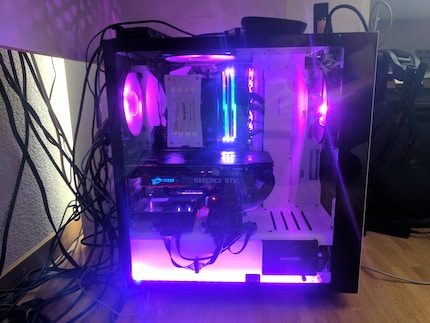
Availability & price trend
Here at digitec, we’ve been acutely aware of the rise in cryptocurrencies, too. Christian Seeholzer is the one on our team responsible for graphics cards, amongst other things, and he’s been battling with poor GPU availability since last summer. He can pinpoint the new year as the time when it got even worse.
To give you an example, you now can’t get a GTX 1080 Ti for less than 1,000 Swiss francs. That’s an inflation of 20 per cent within six months. And by all accounts, it’s not likely to get much better any time soon. «The prognosis isn’t looking good at the moment and it’s expected to carry on like this indefinitely,» explains Christian. The most affected products are Vega and RX series AMD cards as well as Nvidia models from GTX 1060 upwards.
While the general lack of flash memory has an impact on costs, the deciding factor really is the miners. That’s why we limited graphics card sales to two per account since last summer. Meanwhile, we’ve even gone a step further and restricted it to two graphics cards from one series. Before, you could in theory buy two Msi 1080s then two Asus ones and two Gigabyte cards. But that’s the end of that. At least, it should be.
According to Christian, buyers are forever coming up with new tricks to get round the system. Some of the most brazen among them used bots that would set up accounts and order themselves. As much as possible, we are trying to stop this kind of hoarding to make sure our gaming community doesn’t miss out.
Nvidia’s ulterior motives
«At Nvidia, gamers always come first.» Is the company really so altruistic? I mean, surely they were pleased to see all the orders coming in. That quote could be truthful if these gamers also had Nvidia shares. If cryptocurrencies crashed, the market would be flooded with cheap graphics cards, with miners wanting to get rid of their hardware overnight.
In the event of this kind of graphics card inflation, gamers would indeed come first – in upgrading for a bargain price. After that, they wouldn’t need to buy another graphics card for a while.
How does mining work?
But I digress. Let’s get back to my project. Cryptocurrency and everything connected with it is an abstract construct. You’ll get a good idea of how it all works by watching this video.
In short, cryptocurrency is based on a decentralised peer-to-peer system. There is no central server that controls transactions or updates accounts. All of that is done by the people using the system. They get a list of all the transactions to date and use this to build what’s known as a blockchain.
Using crowdsourcing, they make sure the blockchain isn’t manipulated. For Bitcoin alone, this requires almost 150 GB data at present. It’s this blockchain that validates future transactions. Each block containing a transaction gets encrypted. It is given an algorithm and is sent to everyone in the network – this is otherwise known as the hash function. To arrive at the function and approve a transaction, it takes a huge amount of computing power. That’s why anyone who lets their PC be used is remunerated. This process is called crypto mining.
As every currency uses different algorithms, not every hardware is as suitable for the job. Bitcoin, for example, is no longer profitable for mining for end users because electricity costs are higher than the return. Only special mining devices (ASICs) in countries with low electricity costs can still be used. However, the situation is completely different with altcoins such as ethereum, which is causing something of a gold-rush sensation.
How does mining work and what do I need to start?
Alongside a strong graphics card and ideally a processor, you need the following three things:
- a wallet
- a mining hub account
- mining software
You need the wallet (digital purse) in order to receive and send cryptocurrency. You don’t need to input any private data to set it up. You will later need your wallet key in the mining hub so you can receive pay for your work. Mining Pool Hub is one example of a well-known hub. As you don’t stand much chance of mining a new coin, it’s worth joining a group. You might want to think of it like a real mine. If you were on your own, you wouldn’t have much chance of finding a gold nugget. But if you did, the whole thing would be for you. On the other hand, there’s a much higher possibility of you finding treasure when there are hundreds of miners. And when something is found, the proceeds are shared amongst you to reward everyone for their work.
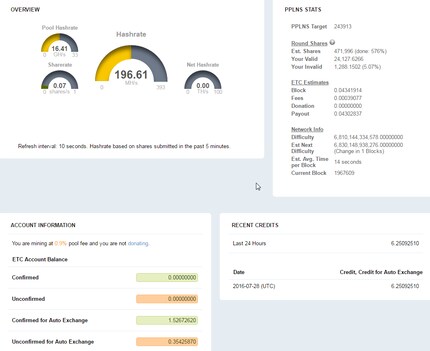
The hub lets you choose which of the different currencies you want to mine. Under the «worker» tab you set a username and password. If you only have one graphics card, one worker is enough. You’ll need the details later when you’re creating a batch file, which consists of a single line of code. It might look something like this:
ethminer -G -S europe.ethash-hub.miningpoolhub.com:20535 -O username.workername:passwordEthminer refers to the programme you want to run. Then you’ve got the server address and your username on the hub site as well as the name and password of the worker.
For the mining process itself, you’ll need another small program for solving the maths equations. There are a lot of options on the market, but not all of them work as efficiently with your hardware. You can normally find them listed on the hub site under the relevant currency.
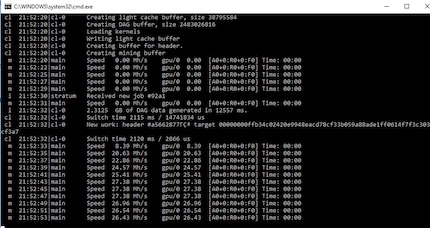
Once you’ve generated the data file in the mining program, all you need to do is double-click and your graphics card will get to work. You’ll always see the current hash rate throughout. This lets you determine how efficient your machine is. It explains how many processes (hash) your computer is capable of per second. Do bear in mind that the hash rate varies from currency to currency.
The whole process isn’t easy for beginners to understand so you will need some time to get used to it.
Electricity costs vs return
I tried Zcash, Zcoin, Ehtereum and TrezarCoin, as these seem to crunch numbers pretty efficiently with the GTX 1080 Ti. To make it easy to read the energy use and electricity costs, I linked up my PC to a Mystrom-Switch.
At full performance, my PC (without a monitor) used around 270 watts. That’s about three rappen per hour. With TrazarCoin, my usage went up to 340 watts. To put that in context: a round of «PUBG» pulls about 370 watts, because it relies on the CPU as well.
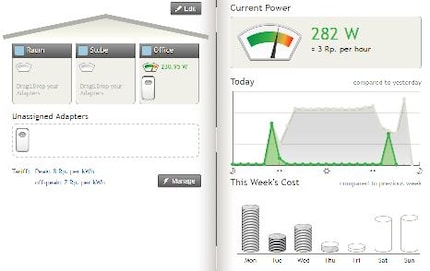
Let’s take Ethereum as an example. If I let my PC run for ten hours, it will cost me 30 centimes for electricity. With a maximum hash rate of 33 MH/s, I can make 0.00111261 ethereum in that time, which at the current rate translates into 85 centimes. Every day for the last few days, I’ve let my computer crunch numbers for a few hours, sometimes even half a day at a time. The result: 0.05817773 Zcoin, 0.01838426 Zcash, 0.00111261 Ethereum and 2.87872769 TrezarCoin. All in all, it comes to about ten Swiss francs.
If I’d bought my GTX 1080 Ti purely for crypto mining, I’d need to run it constantly for about seven months just to get the return on my investment. That is assuming the market remained stable, which isn’t really the case at the moment. While you can overclock the card and there will probably be a whole host of tricks to increase efficiency, I wouldn’t count on there being a big difference.
Of course, this is all without factoring in the transaction costs each time you request the money you made to be paid. In theory, you also have the depreciation of your hardware...
Risks & life cycle assessment
You should be careful not to overload the graphics card. These kinds of consumer products were not made for constant use over long periods of time. In fact, constant heat accelerates the ageing process. The weakest links are probably the supply and the fan. That’s why it’s a good idea to run a monitoring tool like MSI Afterburner. This lets you limit the temperature of the graphics card or turn up the ventilation.
If you’re not worried about your CPU, then at least do it for the environment. Crypto mining gobbles so much energy. Bitcoin alone swallows 42 TWh of electricity each year. That’s more than New Zealand’s total electricity consumption. While Bitcoin is by far the greediest cryptocurrency of the lot when it comes to energy, they are all electricity guzzlers at the end of the day.
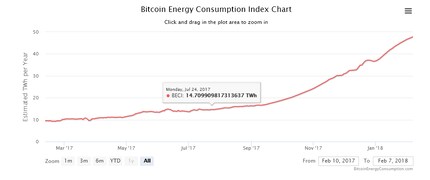
Verdict: it’s fun to give it a try
I already knew the result beforehand, but I wanted to give it a go anyway. After trialling the graphics card with cryptocurrencies, I’d say it’s hardly worth buying a GPU just for crypto mining. Even if you’re running the card 24/7, you’ll hardly make more than 150 Swiss francs per month. And you’d have to forget gaming.
But if you really can’t help yourself and want to get stuck into the world of cryptocurrency, invest in at least one card where you can break even as quickly as possible. Given hardware prices have increased dramatically and cryptocurrencies are subject to extreme fluctuations, you want to make sure you get your investment back. However, you could do just as well to invest directly in cryptocurrency.
Another option is to mine altcoins that aren’t that well known yet. The success rate here is much higher and you’ll manage to pull a few coins together fairly quickly. If you’re lucky, one of them might even end up being the next Ethereum.
But here’s the thing: gone are the days when you could make a tonne of money from crypto mining without a high and risky investment. If you already have a powerful card and don’t have any qualms about environmental issues, you could try it out for fun. If you do, let me know in the comments what you bought with those few Swiss Francs you made.
As a child, I wasn't allowed to have any consoles. It was only with the arrival of the family's 486 PC that the magical world of gaming opened up to me. Today, I'm overcompensating accordingly. Only a lack of time and money prevents me from trying out every game there is and decorating my shelf with rare retro consoles.
Interesting facts about products, behind-the-scenes looks at manufacturers and deep-dives on interesting people.
Show all